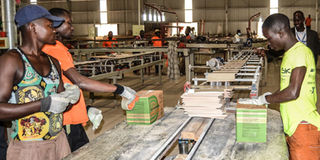Nakaseke’s industrial park, business hub take shape

At work. Some of the workers at a tiles production plant located at Kapeeka Sub-county in Nakaseke District on November 25, 2018. PHOTO BY DAN WANDERA
What you need to know:
- Sensing the effects of destroying environment as a result of constructing factories and the cutting of trees for both charcoal and timber by residents, the district council in 2017 passed a resolution for the creation of a green belt at both the industrial park and the urban areas.
NAKASEKE. When Nakaseke District Council endorsed a proposal to have some portion of their land in Kapeeka Sub-county allocated for the establishment of an industrial park in 2010, the only known features in the location were perhaps the mass graves and maize gardens.
Gen Salim Saleh, the coordinator of Operation Wealth Creation, was then actively engaging farmers in commercial maize growing.
Today, the area is quickly turning into an industrial park with many activities.
Located about 55kms from Uganda’s Capital Kampala and about 41kms off the busy Kampala- Gulu Highway, the mushrooming residential area is an indicator of a fast growing town.
There are also more than 15 industries producing items ranging from electronics, grains, fruit processing and packaging.
The Industrial Park Zone, according to Nakaseke District leaders, stretches to four out of the five parishes of Kapeeka Sub-county and covers more than two square miles.
Mr Ignatius Kiwanuka Koomu, the Nakaseke District chairperson, said: “It is very true Kapeeka is not only a dreamland for the people of Nakaseke, but a fast growing business hub after the successful commissioning of more than 15 industries producing different commodities and employing more than 2,000 Ugandans.
Recently, the district council endorsed a proposal to have the town upgraded to a municipality status and the matter is currently before Ministry of Local Government.
While both the district and sub-county authorities say more than 15,000 Ugandans have got jobs at the newly established factories, Mr Lui Ming Shu, the director of the Liao Shen Industrial park, a consortium of the more than 15 Chinese owned factories at the park, recently told President Museveni and guests that the factories employ about 2,000 Ugandans.
Passing resolution
Sensing the effects of destroying environment as a result of constructing factories and the cutting of trees for both charcoal and timber by residents, the district council in 2017 passed a resolution for the creation of a green belt at both the industrial park and the urban areas. The district teamed up with the management at the industrial park to have more than 2,000 trees planted.
Mr Richard Ssendege, a farmer at Nalumunye Village in Kapeeka Sub-county, is among the beneficiaries of the fruit factory where he sales his mangoes and gets residue he uses as manure on his farm.
Nakaseke South Member of Parliament Paul Lutamaguzi says although the industrial park has changed the face of the former remote village in terms of infrastructure, a section of residents are threatened with eviction from their land yet they are expected to grow food that will feed workers and also provide fruits to the fruit factory.
Statistics
Nakaseke is part of Luweero Triangle, which was the epicentre of the five-year guerrilla war that ushered Mr Museveni’s government to power into 1986.
While the 2014 National Housing and Population Census puts the population of Kapeeka Sub-county at 40,117, authorities estimate the population to have shot to 43,000 as a result of continued influx of workers at the factories.
Figures from the 2014 national census showed that 58 per cent of the population in the productive age bracket of between 14 and 64 years, about 10.4 million people, is unemployed. While a 2017 Sauti wa Wananchi by Twaweza, a non-governmental organasitation, shows that 78 per cent of Ugandans felt government was not doing well in creating jobs.



